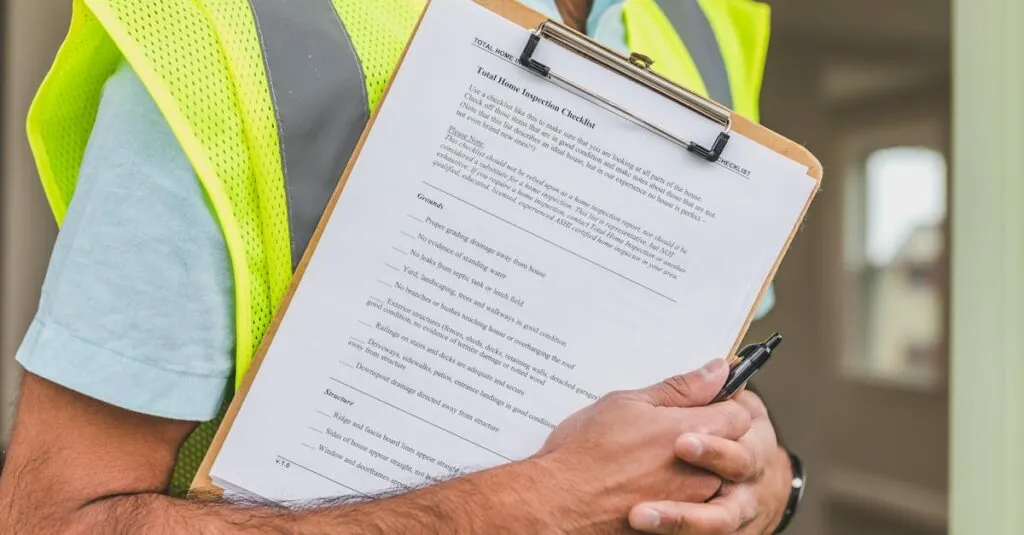Table of Contents
ToggleIn the fast-paced world of technology, keeping IT systems running smoothly can feel like herding cats—frustrating and chaotic. But fear not! An IT maintenance checklist is here to save the day, turning your tech troubles into a distant memory. Think of it as your trusty sidekick, ensuring that servers don’t crash and software doesn’t throw tantrums.
With a well-crafted checklist, IT professionals can tackle routine tasks with the precision of a ninja. From updates to backups, each item is a stepping stone toward a more efficient and secure tech environment. So why gamble with your IT health? Embrace the magic of organization and watch as your systems transform into a well-oiled machine, leaving you more time for coffee breaks and cat videos.
Importance of an IT Maintenance Checklist
A comprehensive IT maintenance checklist ensures consistent system performance. It streamlines the process of managing updates, backups, and security checks. Regularly following such a checklist can mitigate risks associated with system failures. Employees gain peace of mind knowing critical tasks are addressed systematically.
Routine assessments help identify potential vulnerabilities before they escalate into significant issues. IT professionals can prioritize urgent updates based on their impact on overall system functionality. Utilizing a checklist saves valuable time and resources through organized operations. Frequent maintenance fosters a more resilient infrastructure, capable of adapting to evolving technological demands.
Documentation of completed tasks enhances accountability within IT teams. Performance metrics gathered through consistent checklists enable informed decision-making regarding future IT investments. Fostering a proactive approach leads to improved system uptime and user satisfaction.
Integrating a checklist into daily operations promotes a culture of reliability and efficiency. When organizations commit to regular maintenance, they experience fewer disruptions and enhanced security measures. Prioritizing this practice leads to smoother operations and strengthens the overall health of IT systems.
Key Components of an IT Maintenance Checklist
An effective IT maintenance checklist includes several vital components that ensure the smooth operation of technology systems.
Hardware Maintenance
Hardware maintenance encompasses routine inspections and timely repairs. Technicians should regularly check components like servers, workstations, and peripherals for physical signs of wear. They must clean hardware to prevent dust accumulation that can lead to overheating. Upgrading components, such as RAM or storage drives, keeps systems efficient. Scheduled replacement of outdated devices enhances performance and reliability. Documents of all maintenance activities support accountability and transparency among IT teams. Regular assessments help identify potential issues before they escalate into costly breakdowns.
Software Updates
Software updates play a crucial role in maintaining security and functionality. IT professionals must monitor software versions and apply updates promptly to protect against vulnerabilities. Regular checks of operating systems, applications, and security software ensure configurations remain current. Automation tools can streamline the update process, reducing the chances of human error. Tracking update completion fosters accountability and provides insights into software performance. Staying informed about software lifecycle support policies helps organizations plan for necessary upgrades or replacements, aligning with operational goals.
Network Optimization
Network optimization focuses on enhancing connectivity and performance. IT teams should continuously monitor network traffic patterns to identify and resolve bottlenecks. Regular assessment of routers, switches, and firewalls ensures optimal configuration for security and efficiency. Employing bandwidth management techniques helps prioritize critical applications and services. Analyzing data flow enables teams to address latency issues effectively. Documenting network architecture and changes promotes organizational knowledge and preparedness for future upgrades. Regular maintenance of network hardware reduces downtime and supports seamless communication across the organization.
Best Practices for Implementing an IT Maintenance Checklist
Implementing an IT maintenance checklist requires strategic practices that maximize effectiveness and ensure smooth operations.
Regular Audits
Conducting regular audits remains essential for maintaining system integrity. These assessments reveal areas in need of improvement, allowing proactive measures to address vulnerabilities. Professionals should schedule audits quarterly to align with industry best practices. Revisiting the checklist during audits can help refine processes based on evolving technology standards. Identifying gaps in hardware, software, and network functionality ensures teams tackle critical issues promptly. Teams benefit from a structured review, which fosters accountability and enhances overall IT performance.
Documentation and Reporting
Clear documentation and comprehensive reporting are vital components of effective IT maintenance. By keeping accurate records, teams can track completed tasks and maintain compliance with organizational standards. Reporting findings from maintenance checks provides invaluable insights into system health. Establish consistent formats for documentation to streamline information sharing across departments. Regular updates keep stakeholders informed and engaged in ongoing IT initiatives. Using metrics gathered from reports helps teams prioritize future maintenance needs based on past performance trends.
Tools for Managing an IT Maintenance Checklist
Using the right tools is vital for effectively managing an IT maintenance checklist. Various software applications streamline processes, automate tasks, and enhance coordination among IT teams.
- Task Management Software: Platforms like Asana and Trello help organize maintenance tasks, assign responsibilities, and track progress. These tools promote transparency and accountability, crucial for any IT environment.
- Monitoring Tools: Systems such as Nagios and Zabbix provide real-time monitoring of network performance and system health. Utilizing these tools allows IT professionals to identify issues before they escalate, ensuring optimal system performance.
- Documentation Solutions: Tools like Confluence or Google Docs enable teams to document completed tasks and share insights. Consistent documentation enhances compliance and facilitates ongoing communication about system health across teams.
- Backup Software: Solutions like Acronis and Veeam automate regular backups, ensuring data recovery options during system failures. These tools provide peace of mind, allowing teams to focus on other essential activities.
- Patch Management Tools: Applications such as ManageEngine and Automox support timely software updates across the organization. Implementing patch management tools reduces security vulnerabilities, maintaining compliance and overall system integrity.
- Reporting Tools: Utilizing software like Power BI or Tableau can visualize performance metrics from routine tasks. Reports generated inform decision-making regarding future IT investments, optimizing resource allocation.
Selecting appropriate tools fosters an organized and efficient IT environment. Each tool enhances specific aspects of the maintenance checklist, ensuring that teams can address vulnerabilities and maintain system stability effectively. Prioritizing these tools cultivates a proactive approach to IT management, essential for adapting to evolving technological demands.
Conclusion
Implementing an IT maintenance checklist is a game changer for organizations looking to enhance their tech infrastructure. By streamlining routine tasks and ensuring consistent performance, IT professionals can focus on strategic initiatives rather than constant troubleshooting.
Regular audits and documentation not only promote accountability but also help identify areas for improvement. Utilizing the right tools further amplifies efficiency and supports proactive management.
Prioritizing IT maintenance ultimately leads to a more secure and resilient environment that adapts to technological advancements. Embracing this approach fosters a culture of reliability and empowers teams to deliver optimal performance.







